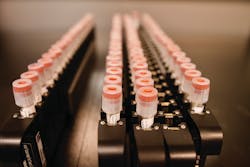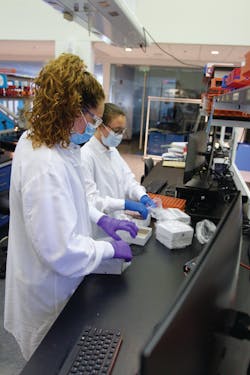In the last two years, the healthcare industry and world learned many lessons in adapting to rapidly changing needs. When processing massive amounts of tests amidst a pandemic, traditional lab workflows were not ready to meet the scalability required to achieve the testing numbers needed to process tests in a timely fashion. Every small delay, even just 30 seconds, adds to a process that must be repeated 10,000 times each day. A 30 second delay repeated 10,000 times adds up quickly.
Standardization is key to scale
At the start of the pandemic, there was no standardization for lab testing. Processes for accessioning, taking samples, and reporting were haphazard. There was limited access to testing across the country, and the time for test processing was so long that it made testing negligible in slowing the spread of the pandemic. The healthcare industry was desperate for increased capacity for testing and test processing speed.
Director of Operations and Development at the Broad Institute Genomics Platform, Tim DeSmet, looked to an outside partner for assistance with their effort to transform their Clinical Research Sequencing Platform CLIA-certified lab into a high-throughput testing facility to assist Massachusetts in combatting the pandemic. DeSmet said during a recent webinar, “We knew we would have to think differently. We had to deconstruct the paradigm and have a standardized, simple solution. We needed to have a tube and a swab and to take paper off the shelf.”
The Broad Institute transformed its facility in less than two weeks to a high-throughput diagnostic testing lab, building new walls to isolate workers and infectious samples, acquiring new PPE for staff, devising a staffing model that would eventually allow for 24-hour operations, and adapting robotics to accelerate a standard processing protocol.
The pandemic is the final goodbye to paper orders when scale is needed
While the innovation continued inside the lab throughout the pandemic, DeSmet knew they would need to address the inefficiencies outside the walls of their institute, as well. One of the early examples of innovation was the creation of digital roster orders for organizations. The team was conducting testing in long-term care facilities, and it would take 20 staff members to go into the care facility to take samples and put the order into a spreadsheet prior to sending samples to the lab. The process to get the orders into the lab was a significant factor in the processing times.
It became apparent that a solution for high-throughput COVID ordering was needed immediately. Labs needed patients to be registered quickly and to ensure all the needed patient data was collected at the time the specimen was collected. A process was developed to enter patient information for an order with a roster. Whether this roster was coming from the long-term care facility, university, or employer, orders could now come as a roster from any source outside of the EMR.Instrument-ready barcodes became the standard
Not only was there a need for a single type of tube and swab, where originally specimens were coming to the lab in more than 15 different tube types, but the barcode now needed to be standardized, as well. Barcodes on tubes for the Broad Institute needed a universal number that was unique to their organization and would work every time and with ease. Once this was accomplished, all information would be immediately available to Broad Institute when scanning the tube in the lab.
Additionally, demographics had to be collected in advance that were required for state reporting. The solution for collecting this information had to be nimble to adjust to the constant changes in the data requirements that could differ for the various public health agencies. The Broad Institute would not be able to make 150,000 calls per day to verify a patient’s race and ethnicity. All the patient and CARES Act-required information had to be gathered at the front of the testing process. This simplification was one of the key components that made the ramp up of testing to scale possible.
Originally the Broad Institute had planned to use prelabeled tubes, thinking it would save time and be a simpler, easier workflow. But every tube must have a connection to the patient, and the information on the barcode must be correct. With up to 150,000 orders and tests per day, ensuring every prelabeled barcode matched to a patient couldn’t be guaranteed. The decision was made that labels had to be printed on site, at the time of the collection. The Broad Institute was able to acquire a large supply of printers for labels to ensure anyone submitting orders was using the same printer for barcodes and that barcodes across all orders received would be uniform. At the end of an order, the test site had no option but to print a label.
Patient self-registration is essential for speed
A key innovation was to ensure a centralized method for handling data intake and output. Large amounts of patient data had to be stored and accessible for sharing in a variety of methods to ensure state reporting, result delivery to patients, result delivery to ordering physicians or practices, and, later, connectivity directly with wellness applications.
Labs needed to be able to accept orders from a multitude of systems, not just EHRs. Interfaces have always had to solve the challenge of integrating with many varied EHRs for bi-directional connectivity. The pandemic put the phrase “vendor agnostic” to the test. Software teams had a new challenge of needed integration with human resource systems, legacy student systems, and many other personnel management software of varied processing capability.
Once the Broad Institute completed their processing innovations inside of the lab and had a partner for high-throughput automatic accessioning, the results were immediate. Broad Institute went from processing 1,000 tests per day to more than 30,000 tests per day in just 2-3 weeks. Today, the Broad Institute has capacity to process up to 150,000 COVID-19 tests every day.
Automated reporting to public departments of health
With the Broad Institute, once their accessions and internal processes were running smoothly, it was apparent the state reporting element also had to be simplified. Just as Broad Institute staff were not able to make tens of thousands of phone calls, they were also not going to fax 150,000 test results or create CSVs for uploading results to state health department portals.
Initially, there was some faxing of results to public health departments, but it was clear this would not be scalable long-term. The Broad Institute’s partner was able to validate an ELR integration with the state reporting agencies. A change for public health departments was to improve communication channels so testing information could be received electronically. A relationship was quickly developed to implement bi-directional connectivity for reporting, and to ensure results were reported to the agency in their specified format.
The value of having reporting connections to departments of health not only brought speed and agility to the testing process but helped public health departments identify how the pandemic was spreading and where the hot spots were emerging.
Patient access is no longer a luxury
A central, cloud-based hub was an essential key to high-throughput COVID testing. The orders and results resided in the hub so patients could gain access to their information through the patient portal whether their test was taken at a patient service center, a doctor’s office, or through their employer. The CARES Act required results be delivered directly to patients to control the spread of COVID-19. When patients tested positive, state reporting was completed while also notifying the patient and the providers so they could initiate follow up.
With all the information being centralized, the burdens of the actions taken outside the walls of the lab were off-loaded from the Broad Institute. From patient intake to instrument-ready barcodes, and after results were determined, state reporting, patient reporting, and sending results to physicians for follow up, the third-party information handling ensured the actions were completed. This allowed the Broad Institute to focus on automating their processes inside the lab, like automating cap removal and standardizing test tubes. The result was going from 1,000 orders a day to 30,000, to eventually 150,000 orders and results a day, an incredible feat.
The look ahead for infectious disease testing
A large amount of wellness applications appeared on the scene during COVID, and it continues as a trend today. As people are again able to travel, attend events, and return to the office, rapid testing has become the norm. A centralized, cloud-based platform has become an essential ingredient for efficient infectious disease testing, especially when there is a desire to test at a large scale.
COVID has accelerated the rise of point-of-care testing, as well as empowering patients to take control of their own care and complete tests in their home. The lab workflows of yesterday are put to rest, where an order could be rejected due to bad handwriting, as we make space for a more patient-centric approach, allowing the patient to complete self-registration, ensure ask on order entry (AOE) questions are complete in the front end, and contain all the required information in a barcode tied to a centralized platform.
Philippe Flamant is the Vice President of Solutions Engineering at ELLKAY.
About the Author

Philippe Flamant
VP Solutions Engineering at ELLKAY has 20 years of industry experience to help hospitals and laboratories with integration and interoperability solutions. Prior to joining ELLKAY, he served as the Chief Operating Officer at CareEvolve as well as being the Product Manager of all CareEvolve products. Philippe holds a Bachelor of Science in Business Administration from Carnegie Mellon University. In addition, he is a member of HL7, actively involved in standards, and a leading laboratory subject matter expert.

